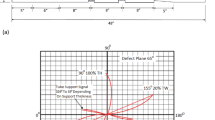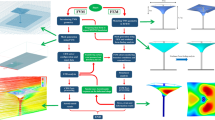Abstract
The behavior of a blast proof door under a blast load was investigated experimentally and analytically. An experiment was carried out to study the behavior of the blast proof door induced by explosive detonation. Subsequently, a finite element analysis was performed using the Lagrangian and Arbitrary Lagrangian Eulerian methods for comparison with the experimental results. The experimental results indicated that the blast proof door was bent due to the blast wave induced by the explosion, and an elliptical opening was formed on it. This study demonstrated that the Arbitrary Lagrangian Eulerian method is a better predictor for the detailed shape of the blast proof door after an explosion, while the Lagrangian method is a better predictor at the tearing of the boundary between the blast proof door and the splice. It was further noted that the overall deformation of the blast proof door using the Lagrangian method is more significant than that elicited using the Arbitrary Lagrangian Eulerian method.
Similar content being viewed by others
References
Teeling-Smith, R. G. and Nurick, G. N., “The Deformation and Tearing of Thin Circular Plates Subjected to Impulsive Loads,” International Journal of Impact Engineering, vol. 11, no. 1, pp. 77–91, 1991.
Nurick, G. N. and Shave, G. C., “The Deformation and Tearing of Thin Square Plates Subjected to Impulsive Loads-An Experimental Study,” International Journal of Impact Engineering, vol. 18, no. 1, pp. 99–116, 1996.
Nurick, G. N., Gelman, M. E., and Marshall, N. S., “Tearing of Blast Loaded Plates with Clamped Boundary Conditions,” International Journal of Impact Engineering, vol. 18, no. 7, pp. 803–827, 1996.
Quan, X., Birnbaum, N. K., Cowler, M. S., Gerber, B. I., Clegg, R. A., and Hayhurst, C. J., “Numerical Simulation of Structural Deformation under Shock and Impact Loads using a Coupled Multi-Solver Approach,” Proc. of 5th Asia-Pacific Conference on Shock and Impact Loads on Structures, pp. 12–14, 2003.
Belytschko, T., Krongauz, Y., Organ, D., Fleming, M., and Krysl, P., “Meshless Methods: An Overview and Recent Developments,” Computer Methods in Applied Mechanics and Engineering, vol. 139, no. 1, pp. 3–47, 1996.
Camacho, G. T. and Ortiz, M., “Adaptive Lagrangian Modelling of Ballistic Penetration of Metallic Targets,” Computer Methods in Applied Mechanics and Engineering, vol. 142, no. 3, pp. 269–301, 1997.
Radovitzky, R. and Ortiz, M., “Lagrangian Finite Element Analysis of Newtonian Fluid Flows,” International Journal for Numerical Methods in Engineering, vol. 43, no. 4, pp. 607–619, 1998.
Hu, H. H., Patankar, N. A., and Zhu, M. Y., “Direct Numerical Simulations of Fluid–Solid Systems using the Arbitrary Lagrangian–Eulerian Technique,” Journal of Computational Physics, vol. 169, no. 2, pp. 427–462, 2001.
Deng, R.-B. and Jin, X.-L., “Numerical Simulation of Bridge Damage under Blast Loads,” WSEAS Transactions on Computers, vol. 8, no. 9, pp. 1564–1574, 2009.
Livermore Software Technology Corporation, “LS-DYNA Keyword User’s Manual,” http://wwwlsdynaeu/fileadmin/files/lsdyna/website/ pdf/pdf_lsdyna/Keyword_Manual_950pdf (Accessed 25 NOV 2015)
Schwer, L., “Optional Strain-Rate Forms for the Johnson Cook Constitutive Model and the Role of the Parameter Epsilon_0,” http:// wwwdynalookcom/european-conf-2007/optional-strain-rate-formsfor-the-johnson-cookpdf (Accessed 25 NOV 2015)
Schwer, L., “A Brief Introduction to Coupling Load Blast Enhanced with Multi-Material Ale: The Best of Both Worlds for Air Blast Simulation,” http://wwwdynamorede/de/download/papers/forum10/ papers/J-I-01pdf (Accessed 25 NOV 2015)
Slavik, T. P., “A Coupling of Empirical Explosive Blast Loads to Ale Air Domains in LS-DYNA®,” Proc. of IOP Conference Series: Materials Science and Engineering, vol. 10, no. 1, Paper no. 012146, 2010.
Author information
Authors and Affiliations
Corresponding author
Rights and permissions
About this article
Cite this article
Choi, Y., Lee, J., Yoo, YH. et al. A Study on the behavior of blast proof door under blast load. Int. J. Precis. Eng. Manuf. 17, 119–124 (2016). https://doi.org/10.1007/s12541-016-0015-y
Received:
Revised:
Accepted:
Published:
Issue Date:
DOI: https://doi.org/10.1007/s12541-016-0015-y




